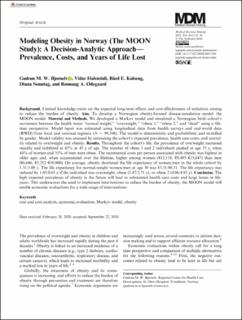| dc.description.abstract | Background. Limited knowledge exists on the expected long-term effects and cost-effectiveness of initiatives aiming to reduce the burden of obesity. Aim. To develop a Norwegian obesity-focused disease-simulation model: the MOON model. Material and Methods. We developed a Markov model and simulated a Norwegian birth cohort’s movement between the health states ‘‘normal weight,’’ ‘‘overweight,’’ ‘‘obese 1,’’ ‘‘obese 2,’’ and ‘‘dead’’ using a lifetime perspective. Model input was estimated using longitudinal data from health surveys and real-world data (RWD) from local and national registers (N = 99,348). The model is deterministic and probabilistic and stratified by gender. Model validity was assessed by estimating the cohort’s expected prevalence, health care costs, and mortality related to overweight and obesity. Results. Throughout the cohort’s life, the prevalence of overweight increased steadily and stabilized at 45% at 45 y of age. The number of obese 1 and 2 individuals peaked at age 75 y, when 44% of women and 35% of men were obese. The incremental costs per person associated with obesity was highest in older ages and, when accumulated over the lifetime, higher among women (e12,118, e9,495–e15,047) than men (e6,646, e5,252–e10,900). On average, obesity shortened the life expectancy of women/men in the whole cohort by 1.31/1.08 y. The life expectancy for normal-weight women/men at age 30 was 83.31/80.31. The life expectancy was reduced by 1.05/0.65 y if the individual was overweight, obese (2.87/2.71 y), or obese 2 (4.06/4.83 y). Conclusion. The high expected prevalence of obesity in the future will lead to substantial health care costs and large losses in lifeyears. This underscores the need to implement interventions to reduce the burden of obesity; the MOON model will enable economic evaluations for a wide range of interventions. | en_US |

